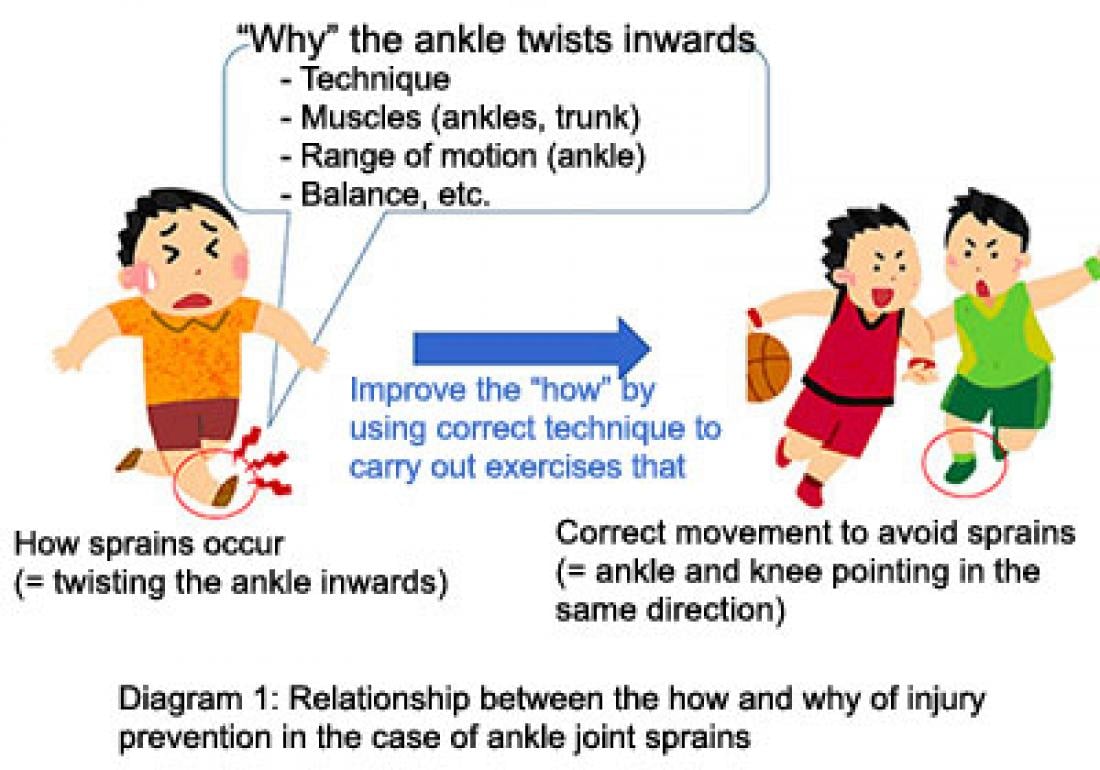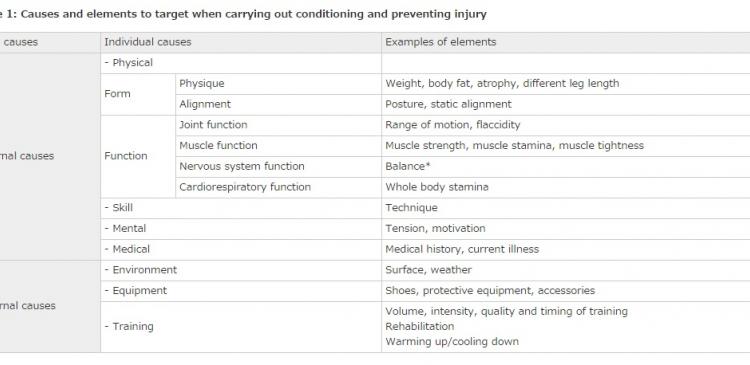Diagram 1: Relationship between the how and why of injury prevention in the case of ankle joint sprains.
Do you enjoy playing sport? Many of us start exercising at this time of year after worrying about overeating during the holiday season. The most important thing when trying to improve sporting ability or lose weight is to continue exercising. One of the things that stops us from keeping up with exercise is injuries. Below I will be introducing some of the global initiatives and the latest knowledge and methods for preventing injuries during sporting activity.
Moving from “rapid healing” towards “preventing injury”—global initiatives in sporting injury prevention—
Injuries suffered during sport are referred to as “sports injuries” and can be divided into acute trauma suffered as a result of a sudden stress, such as a sprain, and chronic injuries suffered as a result of repeated small stresses on the same part of the body, such as knee pain. It is important to prevent both types of sporting injuries because they both stop people from playing sport and keeping up with exercise.
In recent years, sports injury prevention has attracted attention at a global level. Regular international meetings are hosted by the International Olympic Committee (IOC) on the theme of preventing injuries.
The importance of preventing injuries is widely known, and preventive methods have been suggested based on scientific evidence1, but it remains the case that appropriate methods have yet to be put into practice on sports fields. So how should we go about preventing sports injuries?
Moving from “warming up” to “preparing”—prehabilitation as an injury prevention method—
In recent years, preparing the body before exercise has been prioritized and widely practiced as a conditioning method for the prevention of sports injuries. The important thing here is that during pre-exercise warming up it is important to “prepare” and not just “warm up” the body. It has been reported that continuous use of exercises that promote functional use of the body, instead of general warming up such as jogging, can prevent nearly 50% of severe acute trauma and chronic injuries in young athletes and female athletes 1. This form of exercise is referred to as prehabilitation2.
I promote the following six function-improving exercises as prehabilitation for the prevention of sports injuries from the torso through to the legs2. However, these exercises must be carried out correctly. Why do we need to select these six elements and implement them correctly?
(1) Whole body coordination (2) Mobility (3) Muscle function
(4) Balance (5) Optimized movement (6) Plyometrics
* The key is to concentrate on preparing the trunk muscles when carrying out these six exercises!
Methods for preventing injuries by thinking about injury mechanisms—the “how” and the “why”—
When thinking about what kind of prehabilitation to carry out, the first thing we need to consider is how and why the injuries occur. Try to imagine an ankle sprain (Diagram 1). Many ankle sprains are caused by twisting the ankle inwards at the moment of landing or turning. In other words, if the ankle is straight during exercise there will be no sprain! This is an improvement that can be achieved by thinking about “how” an injury occurs.
So why do people’s ankles twist inwards? A variety of causes become apparent when we analyze the “why”? Possible reasons could include incorrect functioning of the muscles that move the ankle outwards (peroneal muscles), or perhaps declining balancing ability. Ankles are often sprained because of incorrect use of the buttock muscles (gluteus medius, etc.) or stomach muscles (trunk muscle group), which are located far from the ankle. It is possible to stop inward twisting of the ankle and prevent strains by improving these areas! This is a way of improving the “why” of sports injuries.
In other words, the key to prehabilitation is to carry out exercises that achieve improvements in terms of “why” injuries occur, while remaining aware of “how” to move without suffering injuries. There are some small differences between the exercises that people need to carry out in order to prevent injuries, depending on the characteristics of the individual in question. The prehabilitation described above is largely aimed at preventing ankle and knee sprains, and for most people it will improve the “why” of sports injuries. I am sure you can now see why “warming up” is not enough on its own.
Cooperating with experts to find the right exercises for you—discussion between athletes and experts—
As described above, preventing sports injuries is not hard if you have the correct knowledge and methods. However, if you consider the fact that more than 90% of athletes (volleyball players) have experienced ankle sprains3, it is clear to see that proper preparation is not always carried out. In order to improve this situation, the first thing we need to do is ensure that sports players and coaches both acquire the correct knowledge and methods.
It is also important for individuals and experts to work together to come up with exercises that suit the individual. The “how” of ankle sprains described above is the same for everyone, irrespective of age or gender. However, the “why” differs between individuals (Table 1). Forgetting this fact and simply going through the motions by following the latest “theories” or “methods” without understanding the true situation will not necessarily produce results. Instead, it is important to learn “why” you suffer injuries by studying books or speaking to experts, and to work with experts to identify methods for implementing improvements. Experts such as athletics coaches can be found at local fitness clubs, clinics and treatment centers. Let’s work together towards acquiring the correct knowledge and methods for us as individuals and helping to develop healthy bodies and minds and a healthy society through sport.
References
1) Soligard T, et al. (2008). “Comprehensive warm-up programme to prevent injuries in young female footballers: cluster randomised controlled trial.” BMJ, 1-9. (PDF can be downloaded from http://www.bmj.com/content/337/bmj.a2469.pdf%2Bhtml).
2) Norikazu Hirose (2013). “Prehabilitation Coaching Clinic for Preventing Injuries [Shogai Yobo no tame no Purihabiriteshon].” Coaching Clinic 2013 (7), 64-67.
3) Ikuhiro Morikita (2000). “Injuries in Top-level Volleyball Players: Results from a Questionnaire Survey.” Japanese Journal of Orthopaedic Sports Medicine 20 (1), 18-21.
Note 1: One example of this is the FIFA11+ program promoted by FIFA. An introduction of the exercises written in Japanese can be downloaded from the medical section of the Japan Football Association website. The URL is as follows: http://www.jfa.jp/football_family/medical/11plus.html
Note 2: The word prehabilitation was coined by combining “pre” with “habilitation” (which derives from the Latin word habilis, meaning capable or suitable). In other words, prehabilitation means preparing the body in advance so that it can be used properly.
ABOUT THE AUTHOR
Norikazu Hirose
Associate Professor, Faculty of Sport Sciences, Waseda University; Physical Coach for Japan’s National Women’s Soccer Team; Conditioning Coach for JEF United Ichihara Chiba Youth Academy
[Profile]
After graduating in Sports Sciences from the Faculty of Human Science, Waseda University, Professor Hirose joined the Graduate School of Arts and Sciences, The University of Tokyo and completed a Ph. D. there. Specialist fields include athletic training, growth and development.
He has worked as a physical coach for junior and youth soccer players at clubs including Verdy Kawasaki (currently Tokyo Verdy), Nagoya Grampus, Kyoto Sanga and JEF United Ichihara Chiba. Since 2008, he has supported female soccer players, working as a physical coach for Japan’s national women’s soccer team. Recent books include Studying the Female Trunk: How to Add Muscle for a Beautiful Body [Joshi no Taikan Ressun: Utsukushii Karada ni naru Kinniku no Tsukekata] (Gakken Publishing).
He also plans to publish the following book in the near future: Non-Muscular Training for Building Physical Stamina—Tripling Exercise Efficiency with the Aim of Building “Body Harmony” [Tsukarenikui Karada o Tsukuru Hi-Kinniku Toreningu] (Kadokawa Shoten).




